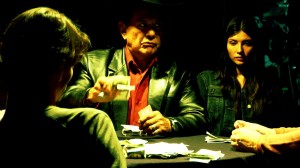It’s a great pleasure writing this blog for my friends behind Reel Injun as I think a documentary is the purest and most concise method of displaying the grotesque nature of Hollywood’s depiction of the indigenous peoples, cultures and nations of North America and the fact that historically they have so consistently been denied opportunities in Hollywood to the extreme of not even playing their own people with Caucasian actors taking the roles too often. Worse than just being disrespectful, Hollywood’s depiction has twisted the psyche of an entire Nation and helped spin and skew the history of a genocide into a triumphant march of progress and greatly helped build the racism that still perpetuates today.
The irony is that the Screen Actors Guild today have rules protecting against discrimination, bound by the equal opportunities laws of the land, that actually protects this discrimination. Now I would be breaking the law to maintain the authenticity I required when casting my movie Rez Bomb by asking the heritage of the actors and actresses submitting to the film and what nation they are from. But of course I received submissions from scores of actors and actresses who looked Native but weren’t. Should I audition them? All I can say is that I did the right thing.
Rez Bomb broke free of all the stereotypes with no leather, feathers or alcohol to be seen. Just people, Lakota and white negotiating a story of love and drama that was originally written for Scotland but rewritten for Pine Ridge. The decision to shoot on Pine Ridge was out of a love of the area and people and I wanted to prove that you can shoot a mainstream story there beyond Hollywood’s perceived necessity that it must be a “culturally Native story”.
But putting that all aside we are moving forward and I think that Hollywood’s despicable history with this has so impacted us that there are great arguments over where cinema in Indian Country should go. My answer is simple. That racism shall still exist until the point where all kinds of stories are being told in all communities and to get to that point we have to further expand the range of ideas being floated out there.
Where Hollywood isn’t so prejudice is towards making a profit and when films by American Indian film makers start to make money consistently then other production money shall start to flow. Ice Cube and Tyler Perry for example have been hugely successful playing in a larger cultural market that Hollywood was ignoring. Although the American Indian market is much smaller it is sustainable for low budget films in itself which can provide a safety net of revenue for investors hoping for something that will also break out and have international appeal.
What follows then is how to create a new distribution model to serve the audience out there waiting for quality American Indian stories. And this is where you all come in. If you’re reading this it is because you are engaged. But that is not enough if you want to see the expansion of American Indian cinema and artists. There are now some very powerful groupings of us on the social networks. We all have to take part in getting the word out about the work we like from these artists whether musicians, film makers, actors, photographers etc.
How many of you out there know about the Baker Twins? I imagine quite a few. Why? Because Shannon and Shauna have worked tirelessly not only on getting themselves established in the entertainment business but also building up their profiles hugely on social networks. I don’t live in Canada so can’t access APTN but could tell you when Tales of an Urban Indian premiered on that channel because of the social networks of the twins. We are all part of that chain but it is only a chain if we all link together and pass the word around.
I was having a debate with V. Blackhawk Aamodt the other night about this issue at a screening of his documentary The Ghost Riders about the Big Foot ride (I highly recommend checking it out) and he was listing a lot of the cultural problems of the depiction of natives in various films. I understand his sentiment. Bury My Heart at Wounded Knee is one where I imagine the producers were patting themselves on the back for their cultural sensitivity but all they did was create another version of Hollywood Indians. Where were the Lakota women? Their absence was culturally ridiculous. White women were oppressed in white culture in those days but Lakota women were not. And where was the laughter? No matter the hardships the Lakota know how to laugh. Because the film makers didn’t have a cultural understanding of the Lakota he well missed the mark.
Now for me I have a far greater problem with that because of the historical significance of the piece than say Shanghai Noon, which also wasn’t culturally accurate but the film didn’t pretend that anything was culturally accurate. The cowboys were goofballs, the Chinese were disciplined and obsessed with honor and the Indians were free and liberated in spirit while still caught in the action of the piece. So long as everyone is treated with the same broad brush for me that’s okay. Pathfinder is not by any means culturally accurate (the Vikings were nothing like that too) but it’s a comic book type movie and nothing in a comic book movie is real. I’ve been looking at a comic book called Scalped set in a mythical Rez and it is so over the top about reservation life it would be objectionable other than for the fact it’s a comic book. New York is nothing like the Gotham City of Batman. As we start to break down the storytelling barriers there will be some depictions where we will have to be a little less sensitive because they get lost in the drama of the mainstream.
I’ve had it said about why did I focus in on a lot of the negative side of reservation life in Rez Bomb? I didn’t. It was written originally to be done in a different country with the same level of drama. And at the end of the day most films are heightened realities to be entertaining. But no-one complained that there are a lot of great looking stars in my film and that’s not realistic to life either. What a world it would be if everyone wandering around looked like Tamara Feldman, Trent Ford, Tokala Clifford or Moses Brings Plenty or with the presence of Russell Means. But it’s a movie. My previous two movies were action films about hitmen in Scotland. That wasn’t realistic but made for exciting movies.
They great thing about creating these movies that are fundamentally entertaining is that we are providing something that is very valuable particularly on the poorer reservations where people have issues over self esteem. For them to watch entertaining movies with stars from their own culture starts to redress the remoteness of a lot of popular culture to their own world. But also powerful is that when these movies travel and are seen by other people it greatly alters their frame of reference to a culture and brings it much closer in wrapped in an empathy we build with our protagonists on screen. This is where popular culture can be more powerful than anything else in society. In a short time Bruce Lee did more to alter the perception of Chinese people in the west than anything else through creating characters people admired and empathized with. I fear that deep, culturally sensitive, more arty films for all their brilliance are too often just seen by like minded thinkers. Once we break through in our storytelling when we have American Indian actors and actresses filling leading roles in entertaining movies that reach out into the world then I think we’ll see a very powerful change in perceptions. It may take time but the most important thing is that we all link up and become parts of the chain to move it towards happening.
In fact with Rez Bomb almost all the film festivals we played internationally were not Native festivals but major mainstream ones and because our leads have mainstream followings we’re finding an audience with our film that are loving it because its an exciting love story and who know nothing about reservation life. So their introduction to it is one where they’re rooting for people who live there. A nice seed to plant.
On a final note, as a Scotsman, when I was young the typical depiction you saw of Scottish characters in mainstream British television was as a drunk or as a thug or invariably both, which was a bit tiresome. Now it was a fraction of the stereotype of the American Indian in media but I am pleased to say as the Scots controlled more of their storytelling and their media this depiction subsided. I say to storytellers be ambitious and bold with your storytelling and think out of the box. Where are the legal drama’s or the teen high school comedies or the love stories? Well they’re starting to happen. Imprint is a ghost story. Turquoise Rose a coming of age drama and Rez Bomb is a love story.
We have to be optimistic. But lets face it, it can’t get as bad as the bad old days of Hollywood.
Steven Lewis Simpson
Steven Lewis Simpson is director, producer, musician and editor who started his film career working for the legendary Roger Corman’s Concorde Pictures. He has directed the feature Ties (best film at the Cherbourg Festival of British Film), the documentary Timor Timor, the action feature The Ticking Man and its sequel Retribution. His latest feature, Rez Bomb, is the first universal story to be set on an American Indian reservation. His documentary, A Thunder-Being Nation, filmed over seven years on Pine Ridge Reservation, will be released soon.

